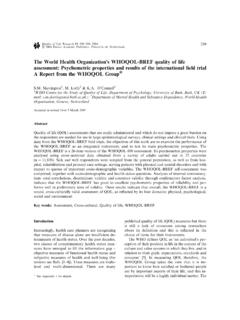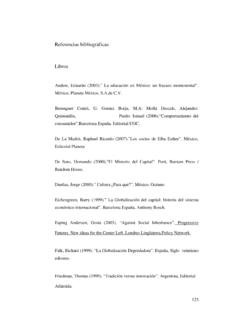Transcription of ARTICLE HOME HEALTH CARE MANAGEMENT & …
1 ARTICLEHOME HEALTH care MANAGEMENT & PRACTICE / april 2003 cultural Influences onPain Perceptions and BehaviorsLynn Clark Callister, RN, PhDThe perception of pain and behaviors associatedwith pain are influenced by the sociocultural con-texts of the individuals experiencing pain. Thisarticle provides an overview of the literature onthese cultural influences. With the increase inglobal migration, nurses need to developincreased sensitivity to the influence of culture onpain perceptions and behaviors. In the provisionof home HEALTH care , it is essential that nurses aresensitive to such influences in the delivery of cul-turally competent care in the assessment andmanagement of both acute and chronic perception is composed of highly interac-tive emotional, cognitive, as well as sensorycomponents (Gijsbers & Niven, 1993, p. 55).Pain is defined by the individuals who are experiencingit (Pasero & McCaffery, 2001). According to theAgency for HEALTH care Policy and Research (1994)guide for acute pain MANAGEMENT , the single most reli-able indicator of the existence and intensity of pain and any resultant distress are patient the pain experience is complex and influ-enced by multiple variables, the perception of pain andbehaviors associated with pain are influenced by thesociocultural context of the individuals experiencingpain (Bates, 1987; Montes-Sadoval, 2000; Rollman,1998; Streltzer, 1997).
2 Pain is a culturally definedphysiological and psychological experience. The clas-sic work of Zborowski (1952) concluded that each cul-ture has its own language of distress when experiencingpain. Gaston-Johannson (1990) noted more than adecade ago that there are similarities in worddescriptors in a variety of cultural groups, with thewordpaincharacterizing the most intense discomfort,the wordhurtcharacterizing less severe discomfort,andachedescribing minimal pain. In home HEALTH careservices, the autonomy of the clients is greater thanthose seen in any other HEALTH care setting (Warner,1997). home care nurses provide assessment, support,and education, playing an important role in the assess-ment and MANAGEMENT of both acute and chronic population of the United States is becomingincreasing diverse11. According to the 2000 Cen-sus, of the population is White, is Blackor African American, are American Indian andAlaska Native, are Asia, and are NativeHawaiian and other Pacific Islander.
3 Hispanic or Latinoor any race constitutes of the to Freedman (2000), One of the implica-tions of globalization is that virtually no culture isuntouched by others (p. 437).With the increase in global migration, nurses need todevelop increased sensitivity to the influence of cultureon pain perceptions and behaviors. The literature onthis topic will be reviewed, including pain toleranceand perception, acute pain such as that experienced bychildbearing women, and chronic pain. Culturallyrelated pain behaviors and knowledge and attitudestoward the MANAGEMENT of pain among nurses will alsobe TOLERANCE ANDPERCEPTION OF ACUTE PAINC ross- cultural studies of pain, pain reaction, andcoping published between 1985 and 1996 have beensummarized (Moore & Brodsgaard, 1999). The most207 home HEALTH care MANAGEMENT & Practice/ april 2003 / Volume 15, Number 3, 207-211 DOI: 2003 Sage PublicationsKey Words:culture; cultural competence; pain; pain per-ception; pain behaviorsfrequently reported cross- cultural differences were pat-terns of the meaning of pain.
4 Coping styles also dif-fered. African American and Caucasian college stu-dents were evaluated on thermal pain responses (C. , Fillingim, & Keefe, 1999). African Ameri-cans rated the stimuli as more unpleasant. Authors con-cluded that thermal pain unpleasantness ratings mayaccount for greater self-reported pain symptoms amongAfrican Americans. Cutaneous pain perceptions havebeen compared in Caucasians and African Americans(Sheffield, Biles, From, Maixner, & Sheps, 2000), not-ing that African Americans rated the stimuli as moreunpleasant and showed a tendency to rate the pain asmore intense than did Whites. Johnson-Umezulike(1999) found a moderate correlation between self-reported pain intensity and ethnicity in a study of olderAfrican Americans and Caucasians, with AfricanAmericans reporting higher levels of pain intensity. In arecent comparative study exploring normative painresponses in college students in the United States andEast India, it was noted that Indian participants hadhigher pain tolerance than did those living in the UnitedStates (Nayak, Shiflett, Eshun, & Levine, 2000).
5 Galanti (2001) described Filipino attitudes toward painmedication, including stoicism and higher pain thresh-olds. In a comparative study of women experiencingcholecystectomy pain, no significant differences werefound in Mexican American and Anglo-Americanwomen (Calvillo & Flaskerud, 1993). In anethnographic study of Mexican Americans who hadhad recent experiences with acute pain or who had fam-ily members with recent pain experience, the followingthemes were identified: (a) Pain is an encompassingperiod of suffering, (b) pain is both expected andaccepted as part of life, and (c) the primacy of caring inthe face of pain and suffering is the essence of family(Villaurruel, 1995).CHILDBIRTH PAINT here is a body of literature on the childbirth painexperience and culture (Callister, 2001; Callister et al.,2002; Callister, Lauri, & Vehvilainen-Julkunen, 2000;Callister, Semenic, & Foster, 1999; Callister & Vega,1998; Callister, Vehvilainen-Julkunen, & Lauri, 1996,2001; Kartchner & Callister, 2003; Khalaf & Callister,1997).
6 Study participants included childbearingwomen living in North and Central America, Scandina-via, the Middle East, the People s Republic of China,and Tonga. Participants described their attitudestoward, perceptions of, and meaning of childbirth pain was viewed as a self-actualizing experi-ence. Women who were active in their religious faithseemed to accept pain as an inevitable and importantpart of life. These women relied on a higher power togive them strength. Culturally related pain behaviorwas also articulated by these participants and variedgreatly from stoicism to strong verbal and nonverbalexpressions. It should be noted that childbirth pain isunique and complex, differing from the pain of disease,trauma, or medical and/or surgical procedures (Niven& Murphy-Black, 2000) and is usually characterized bythe generally positive event of giving birth. Maternalself-efficacy or confidence in women s ability to copemakes a difference in the ability to manage the pain TOLERANCE ANDPERCEPTION OF CHRONIC PAINB ased on a study of 372 chronic pain patients fromsix ethnic/ cultural groups, Bates, Edwards, and Ander-son (1993) generated a model of pain perception andresponse.
7 The impact of ethnicity and level of accultur-ation on pain perception in Hispanic, Caucasian, andAfrican American persons with fibromyalgia has beenevaluated (Caldwell, 2001). There were no statisticallysignificant differences across the three ethnic groups ontotal pain perception. However, it was noted thatfibromyalgia is likely misdiagnosed or undiagnosedamong Hispanics and African Americans in primarycare clinics, indicating there are some implications forthe delivery of culturally competent care . In a compara-tive study of 337 individuals suffering chronic pain,African Americans reported higher levels of clinicalpain and pain-related disability (R. R. Edwards, Daniel,Fillingim, & Lowery, 2001).The influence of culture on cancer pain managementin Hispanics has been described in a qualitative workby Juarez, Ferrell, & Borneman (1998). Cancer painwas the focus of the work done with study participantswho were immigrants from Europe and Eastern Europe(Greenwald, 1991).
8 There were statistically significantdifferences in cultural identity and measures of painsensation. In a study of four different ethnic/culturalgroups, descriptors used to describe pain were bothsimilar and different among cultural groups (Gaston-Johannson, 1990).208 home HEALTH care MANAGEMENT & PRACTICE / april 2003An advanced practice nurse practicing in an ambula-tory care setting extensively compared those livingwith chronic pain in the United States with those livingin East India. Kodiath (1998) concluded that clients inboth cultures who find meaning in their pain showmarkedly less suffering than those who find pain to bemeaningless (p. 46). She purports there are consider-able cultural differences in the meaning of pain, whichthen influence human suffering. Differences in copingmechanisms and beliefs about pain control in AfricanAmerican and White women diagnosed with rheuma-toid arthritis have been identified (Jordan, Lumley, &Leisen, 1998).
9 Pain-coping strategies differ in culturalgroups, and this may be as significant as differences inperceptions of pain (Moore & Brodsgaard, 1999). InMexican American families dealing with chronic child-hood illness, religious faith represented a powerful cop-ing strategy engendering hope and a sense of well-being (Rehm, 1999).PAIN BEHAVIORSPain behaviors vary widely and may be culturallybound. Some clients cope by turning inward, describ-ing pain as a private and personal experience. Other cli-ents are verbally expressive, sometimes crying andscreaming. It has been suggested that people in East-ern cultures have higher pain tolerance than those in theWest (Nayak et al., 2000, p. 146; Khalaf & Callister,1997). In dominant cultures living in the United States,it is postulated that the willingness to verbalize painmay be due to the belief that pain is bad, need not beendured, and should be quickly eliminated (Nayaket al., 2000, p. 146). This may not be true in other cul-tural OF PAIN BY NURSESIn a study of nurses caring for women experiencingsurgical pain, nurses evaluation of patients pain wasless than the patients evaluation (Calvillo & Flaskerud,1993).
10 This is widely supported in the and Texidor (1996) assessed the knowledgeand attitudes toward chronic pain MANAGEMENT in 100home HEALTH care nurses. Of these nurses, 80% had hada recent personal experience with pain and at least 50%had dealt recently with a client experiencing chronicpain. The researchers concluded that there was a needfor additional education of home HEALTH care nurses inanalgesic pharmacology and pain AND IMPLICATIONSFOR CLINICAL PRACTICEPain perceptions and behavior are heavily influ-enced by culture and by the sociocultural context of cli-ents (Rollman, 1998). Level of acculturation and fam-ily support are other considerations (Flaskerud &Uman, 1996). More research is needed to build on thecurrent body of knowledge regarding cultural influ-ences on both acute and chronic have been identified in nurses assess-ments of clients pain and clients perceptions of thatpain (McDermott, 2000). Nurses should be aware ofhow personal beliefs and perceptions make objectiveassessment and treatment of patients pain or overtreatment of pain may result ifnurses are not familiar with the cultural backgrounds ofpatients or make stereotypical assumptions.



